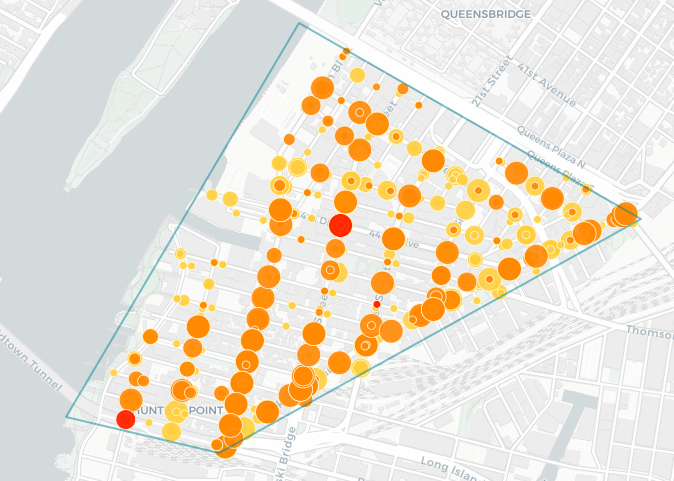Long Island City is getting new protected bike lanes on three dangerous corridors, crucial connectors to the Pulaski and Queensboro bridges — more than two years after advocates and local pols demanded the neighborhood get a full network of protected bike lanes following a spate of cyclist deaths back in 2019.
Department of Transportation officials on Tuesday night unveiled their plans for the new safety infrastructure on 44th Drive, 11th Street, and Jackson Avenue, amid a citywide bike boom that's echoing particularly loudly in Long Island City. Cyclists are now taking more than 6,400 trips across the Queensboro Bridge — which experienced the highest jump of daily riders across the four East River spans — and more than 2,000 trips per day across the Pulaski Bridge, according to DOT. Citi Bike says that it has roughly 1,000 daily rides within the boundaries of Queens Community Board 2.
"What we're looking to do is to continue this growth in cycling by further connecting the neighborhood to the existing infrastructure ... and filling in the gaps," said Craig Baerwald, the operations manager of DOT's bicycle program said at the Tuesday board meeting. "We can expect this number to continue to grow."
And the protections are long overdue, said Laura Shepard, a Queens organizer for Transportation Alternatives. Queens CB2's Transportation Committee voted in favor of the proposal.
"This is very desperately needed ... for a long time," she said during the virtual meeting.
🚲 Happy Tuesday #BikeQNS! The @QueensCB2 Transpo Committee voted to recommend implementing protected bike lanes on 11th St, 44th Dr & a segment of Jackson Ave! #LICBikeNeighborhood
— Laura Shepard (@LAShepard221) April 6, 2022
🗓️ @NYC_DOT will present & the full board will vote on Thursday, May 5th. Mark your calendars! 🚲 pic.twitter.com/1uaZoDR9jV
The work is part of former Mayor de Blasio 's Green Wave plan that was announced during the summer of 2019, a year when a total of 29 cyclists were killed on city streets. One of those cyclists was 53-year-old Robert Spencer, who was killed as he was riding along an unprotected stretch of Borden Avenue near Second Street.
The three new protected bike lanes will be on 44th Drive between Vernon Boulevard and 23rd Street, 11th Street between 44th Drive and Jackson Avenue, and on Jackson Avenue between Vernon Boulevard and the Pulaski Bridge, work that will facilitate the removal of about 10 parking spaces per block, or about 100 parking spots total — roughly equal to 16,200 feet of roadway, a marginal increase towards Transportation Alternatives's goal of reclaiming 25 percent of public roadway space from automobiles.
On the key east-west route of 44th Drive between Vernon Boulevard and 23rd Street — where there have been 117 total reported crashes since March, 2017, causing 40 injuries, including two cyclists and 11 pedestrians, plus one motorist fatality, according to Crash Mapper — DOT will install a six-foot parking protected bike lane on either side of the street, with a five-foot buffer in between.

On 11th Street between 44th Drive and Jackson Avenue — where there have been 161 total reported crashes since March, 2017, injuring 45 people, including to nine cyclists and five pedestrians, according to city stats — DOT will similarly shift the existing bike lane to the curb to create a parking protected bike lane with a buffer. The roadway is the key north-south route between the Pulaski and Queensboro bridges.
And along the last small sliver of Jackson Avenue between Vernon Boulevard and 11th Street south of the cycling entrance to the bridge, Baerwald says DOT will also remove the curbside parking to make room for a protected bike lane and pedestrians islands.

Left out of the proposal are improvements to Borden Avenue and the intersection at the foot of the Pulaski Bridge, which Shepard says is treacherous for cyclists and pedestrians alike. DOT did not address that issue of that intersection, where there have been 68 crashes since March, 2017, injuring six cyclists and 11 motorists, according to city stats.

"That whole intersection needs additional upgrades," she said.
The whole neighborhood does. Since March, 2017, there have been 2,370 crashes in just the 20-block wedge bordered by the Queensboro Bridge on the north, Jackson Avenue on the east and the East River on the west. Those one-per-day crashes have injured 76 cyclists, 100 pedestrians and 339 motorists. Two cyclists and one motorist have been killed.
The agency did say it is looking at ways to make Borden Avenue, between Center Boulevard and Jackson Avenue, safer. That's also a key safety corridor: Since March, 2017, there have been 60 crashes, injuring three pedestrians and 10 motorists, and killing a cyclist along just those four blocks.
The proposal will head to the full board next month.






